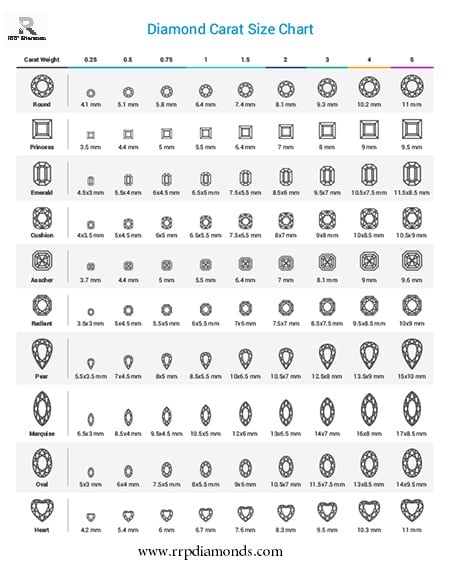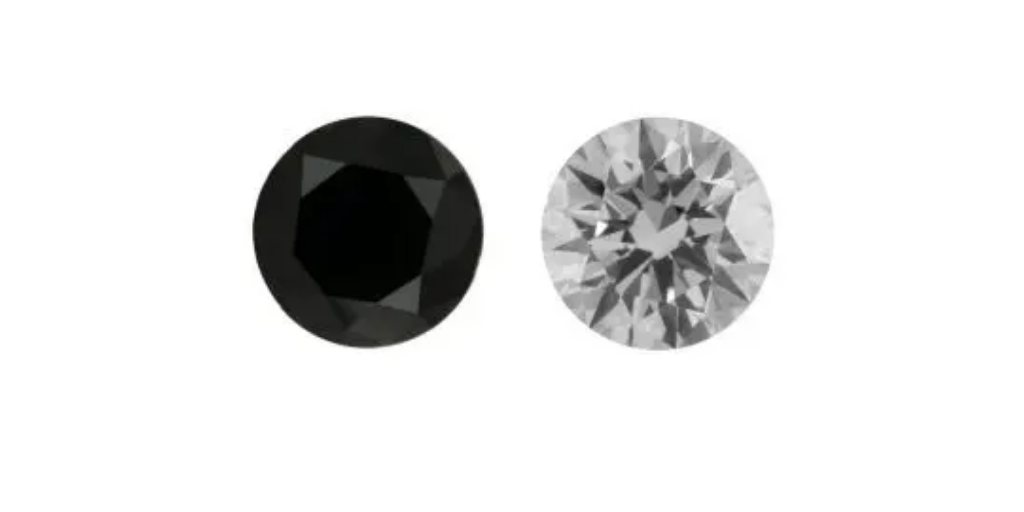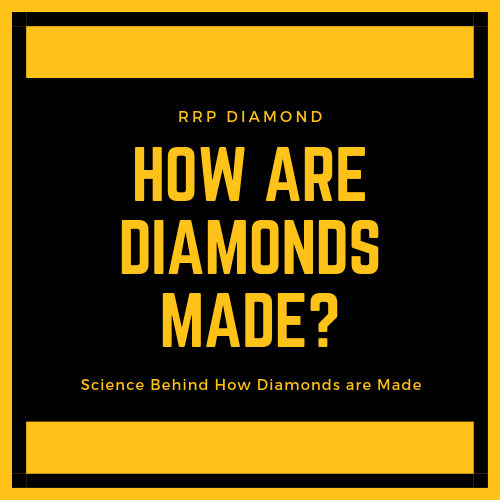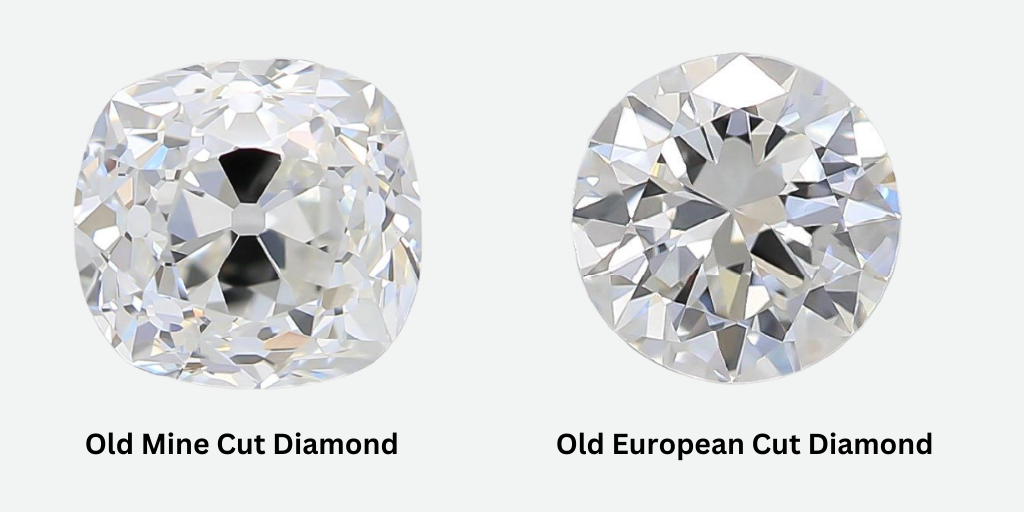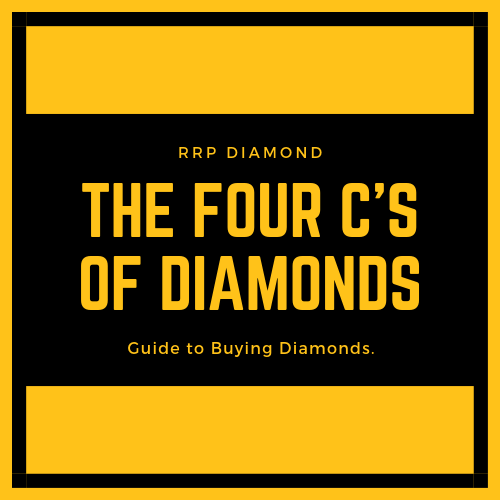
So the time has come and you want to buy a diamond? While most diamonds might look quite similar, there are small factors and attributes that differentiate them from the other. And, these “small” factors and differences make each of them special but more importantly to you – very different in value.
So, why are research and education required when shopping for diamonds? Beyond the listed price tags, there are a lot more factors to consider when selecting a diamond. For example, there are a number of reasons why a diamond can be pricier or cheaper when compared to another diamond with similar specifications.
A diamond’s 4 C’s represent the four main components of its beauty and structure: Cut, Color, Clarity, and Carat. When looking at a diamond, the eye perceives a balance of its characteristics and components, including, but not limited to, the 4 C’s
Buying a diamond does not have to be an uncomfortable experience. The RRP Diamond Education Guide is designed to give you the tools and information you need to properly evaluate diamond quality and value with confidence.
But how can diamonds be compared? How can you evaluate them? Who will evaluate them? This is exactly the reason why a diamond grading system and methodology were invented and Gemological Institutes were created.
Over the years more and more such gemological institutes were established. The most commonly known to date are:
- GIA – Gemological Institute of America
- AGS – American Gem Society
- IGI – International Gemological Institute
- EGL – European Gemological Laboratory
- HRD – Hoge Raad Voor Diamant
The 4 C’s of Diamonds – Standardizing Diamond Grading
Many times, it is the subtle differences between diamonds that can mean a huge difference in optical performance and appearance. And these are the reasons that you need to understand if you want to make the best possible purchase for a given budget. Each of the C’s is graded on a scale and can be evaluated for quality. Though some universal terminology and standard grading exist, it does vary by lab entity.
4C’s Of Diamond
-
-
Cut
-
-
-
Clarity
-
-
-
Color
-
Carat
-
After learning more, if you need to see diamonds in person, visit your local jewelry store. Get a better sense of what you personally value in a diamond. Note the color, cut, and clarity that best fit your needs. While you’re there, compare the prices with what you find at RRP diamond
1. Cut
The diamond industry uses the word “cut” in two different ways. First, it’s used to describe the shape of a diamond (for example, an “emerald cut” diamond). The second way “diamond cut” is used is to describe the reflective qualities of a diamond. The reflective quality of the diamond is determined by how well the diamond was cut.
Diamond-Cut specifically refers to the quality of a diamond’s angles, proportions, symmetrical facets, brilliance, fire, scintillation, and finishing details. Skilled craftsmen transform a rough diamond into a gleaming polished diamond by polishing tiny facets into the rough stone. Facets are the flat, polished surfaces of a diamond. The quality of the cut is crucial to the diamond’s final beauty and value. And of all the 4Cs, it is the most complex and technically difficult to analyze. These factors directly impact a diamond’s ability to sparkle, along with its overall aesthetic appeal. The cut of a diamond refers to its proportion and finish.
It is an art and a science to cut a gem-quality diamond out of a mined rough diamond.
When a diamond is fashioned from a rough stone, the cutter must balance optimal cut (and therefore appearance) against maximum yield (cutting the diamond to maintain as much carat weight from the rough stone as possible). Because many customers are willing to pay more for a larger, fair-cut cut diamond than for a slightly smaller, well-cut diamond, there is pressure on the cutter to sacrifice appearance for weight. This is why the Cut grade is so important; it allows the purchaser to identify those stones that were cut Fair to Poor in an effort to gain carat weight.
As shown in the images below, when a diamond is well-cut, light enters through the table and travels to the pavilion where it reflects from one side to the other before reflecting back out of the diamond through the table and to the observer’s eye. This light is the brilliance we mentioned, and it’s this flashing, fiery effect that makes diamonds so mesmerizing.
The proportion diagram shows the diamond’s girdle size, culet size, table and depth percentages, as well as other measurements, such as the crown and pavilion angles.
Also Read: Top 10 Fantastic Facts About Black Diamonds
Grading Diamond Cut
Most geologists agree that the best-cut diamonds are those that follow a set of formulae calculated to maximize brilliance. These formulae can be seen in a diamond’s proportions, most importantly how the depth compares to the diameter, and how the diameter of the table compares to the diameter of the diamond.
The easy alternative would be to simply use the GIA/AGS cut grading as a filter to select round diamonds. Gemological labs like GIA or AGS take the proportion variations of a diamond into account when assigning a cut grade. If any particular aspect of the cut proportions is an issue, the diamond will be assigned with a lower cut grade accordingly.
A cut grade should be a primary consideration when evaluating a diamond. Only when comparing two diamonds of the identical Cut grade should the individual components of Cut (such as girdle width, symmetry, polish, depth%, table %, and culet size) be used as further refinements or tiebreakers.
A cut grade is assigned by the GIA
|
Excellent |
Maximum fire and brilliance. Reflects nearly all of the light that enters the diamond, creating exceptional sparkle and life. |
| Very Good | Properly reflects most of the light that enters the diamond, producing superior fire and brilliance. Under normal lighting conditions, appears very similar to Excellent Cut, but for a lower price. |
| Good | Reflects a majority of the light that enters the diamond, for an above-average appearance. An excellent value compared to higher cut grades. |
| Fair | Allows much of the light entering the diamond to escape from the sides or bottom, reducing perceived fire and brilliance. More acceptable in diamonds of less than .75 carats, where differences in sparkle are more difficult to perceive. |
| Poor | Allows most of the light entering the diamond to escape from the sides or bottom. The diamond may appear noticeably dull and lifeless, even to an untrained eye |
2. Color
Diamonds come in a variety of colors, some of them highly prized (pinks, blues, even yellow). However, in a white diamond, the presence of a yellow tint will lower the price of a diamond. The less body color in a white diamond, the more true color it will reflect, and thus the greater its value. The diamond color evaluation of most gem-quality diamonds is based on the absence of color. A chemically pure and structurally perfect diamond has no hue, like a drop of pure water, and consequently, a higher value.
Colored diamonds (e.g. black, brown, gray) can negatively affect light absorption, and thus the sparkle of the stone that we see. That is why white (colorless) diamonds are generally more valuable and commonly used in jewelry as they have better reflective qualities. Of course, the exceptions to this rule are the rare and much sought after colors of pink, red, blue, and orange.
The best color for a diamond is no color at all. A totally colorless diamond allows light to pass through it easily, resulting in the light being dispersed as the color of the rainbow. Colors are graded totally colorless to light yellow. The pricing of diamonds usually reflects these grades—sometimes significantly. In most cases, the naked eye cannot tell the difference between two adjacent color graded diamonds, though the price difference may be significant.
The most critical aspect of Color is to determine if it appears colorless in relation to its setting. You also want to be certain that a diamond is clear of any tinting that takes away or interferes with white and colored light reflections. The K Color in this Cushion Cut Diamond, for example, distracts from the sparkle of the diamond while this I Color Diamond is radiant.
To grade ‘whiteness’ or colorlessness, most jewelers refer to GIA’s professional color scale that begins with the highest rating of D for colorless and travels down the alphabet to grade stones with traces of very faint or light yellowish or brownish color. The color scale continues all the way to Z.
The GIA grades diamonds on a scale of D (colorless) through Z (light color). All D-Z diamonds are considered white, even though they contain varying degrees of color.
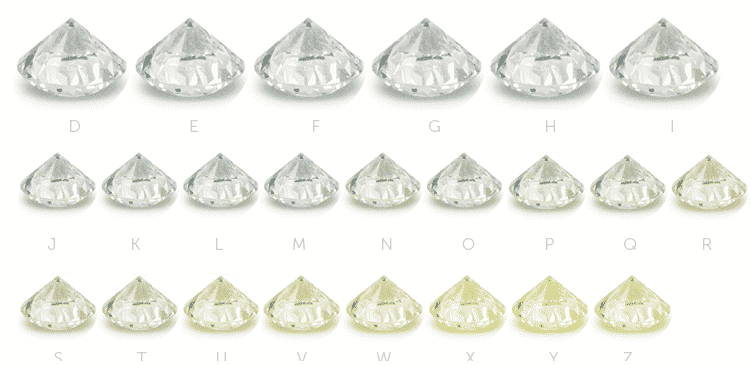
Colorless diamonds are rarer and in higher demand, and therefore more expensive than diamonds with a slight tint of yellow or brown. Most diamonds used in jewelry are basically near-colorless with a slight tint of yellow or brown. Diamonds also come in deeper shades of yellow and brown, as well as in a variety of other colors. These make up the category “fancy colored diamonds”, where the opposite is true: more color usually means higher value.
GIA Diamond Color Scale
Colorless |
 |
While there are differences in color between D, E, and F diamonds, they can be detected only by a gemologist in side by side comparisons, and rarely by the untrained eye.
D-F diamonds should only be set in white gold/platinum. Yellow gold reflects color, negating the diamond’s colorless effect. |
Near Colorless |
 |
While containing traces of color, G-J diamonds are suitable for a platinum or white gold setting, which would normally betray any hint of color in a diamond.
Because I-J diamonds are more common than the higher grades, they tend to be of great value. An I-J diamond may retail for half the price of a D diamond. Within the G-J range, price tends to increase 10-20% between each diamond grade. |
Faint Color |
 |
Beginning with K diamonds, color (usually a yellow tint) is more easily detected by the naked eye.
Set in yellow gold, these warm colored diamonds appeal to some and are an exceptional value. Others will feel they have too much color. Due to its perceptible color tint, a K diamond is often half the price of a G diamond. |
Very Light Color |
 |
Diamonds in the N-R color range have an easily seen yellow or brown tint but are much less expensive than higher grades.RRP Diamond does not carry diamonds in this color range due to a lack of demand. If you desire a diamond in this range, request a price quote using the custom diamond search. |
Light Color |
 |
For almost all customers, S-Z diamonds have too much color for a white diamond.RRP Diamond does not carry diamonds in this color range. If you desire a diamond in this range, request a price quote using the custom diamond search. |
FLUORESCENCE
Fluorescence refers to the degree of luminescence exhibited in certain diamonds when exposed to ultraviolet light or strong sunlight. Most commonly, diamonds display a blue fluorescence, but can also appear in a variety of colors. Faint to medium fluorescence is rarely detected under ordinary lighting conditions. Strong or very strong fluorescence may make a diamond appear ‘milky’ or ‘oily’.
Fluorescence is not always a bad thing as blue fluorescence may enhance the color of a diamond. For example, a diamond graded H with blue fluorescence may appear whiter than it really is. Fluorescence can also hide a slight yellow tint in diamonds graded I, J, and K.
Fluorescence is indicated on a GIA diamond certificate and measured in Faint, Medium, or Strong.
3. Clarity
Clarity measures the incidence of natural inclusions or imperfections found in a diamond. The closer a diamond is too flawless, i.e.: no inclusions visible through a jewelers loupe, the rarer it is and the greater its value. Most inclusions are not visible to the naked eye, so diamonds are examined under a 10x magnifying loupe to determine their clarity.
Clarity is graded by the GIA on the following scale:
-
- FL (Flawless)
-
- IF (Internally Flawless)
-
- VVS1 (Very, Very Slightly Included 1)
-
- VVS2 (Very, Very Slightly Included 2)
-
- VS1 (Very Slightly Included 1)
-
- VS2 (Very Slightly Included 2)
-
- SI1 (Slightly Included 1)
- SI2 (Slightly Included 2)
-
- I1 (Inclusions 1)
-
- I2 (Inclusions 2)
A diamond’s clarity is determined by the number, size, type, and placement of the inclusions, such as tiny white points, dark dots, or feathery cracks naturally found in the diamond. A diamond’s clarity is unique and acts as a fingerprint. When choosing a diamond, you should select a clarity grade in which the inclusions are not visible without magnification. In other words, we recommend diamonds with a clarity grade of SI2 and up.
DIAMOND CLARITY SCALE
| F (Flawless): | No inclusions or blemishes are visible to a skilled gemologist under a 10x magnification loupe. |
| IF (Internally Flawless): | No visible inclusions under a 10x magnification loupe, insignificant surface blemishes. |
| VVS1 – VVS2 (Very Very Slight Inclusions): | Minute inclusions so small they are hardly visible under a 10x magnification loupe. Not visible to the naked eye. |
| VS1 – VS2 (Very Slight Inclusions): | Minor inclusions that are visible under a 10x magnification loupe. Not visible to the naked eye. |
| SI1 – SI2 (Slight Inclusions): |
Noticeable inclusions are seen under a 10x magnification loupe. Not visible to the naked eye. |
| I1 – I2 – I3 (Included): | Inclusions are large and noticeable to the naked eye. For this reason, Shimansky carries only FL to SI clarity diamonds. |
The grading process involves a skilled gemologist who examines the diamond under a 10X powered microscope and subsequently classified it into its clarity rating based on its inclusions. Below is a quick breakdown of what each individual ratings mean.
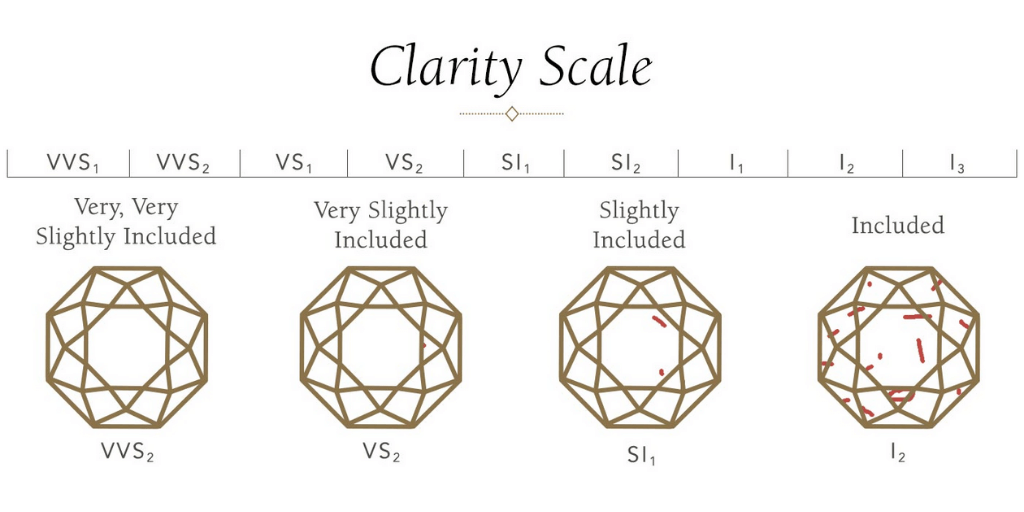
Since diamonds take shape inside the earth under extreme heat and pressure conditions, it is rare to find a diamond without any clarity characteristics.
4. Carat Weight
The carat weight measures the mass of a diamond. One carat is defined as 200 milligrams (0.200 g). Depending on the quality, large diamonds are rarer and more valuable than smaller ones. Diamonds are measured in carats, which take into account the weight, rather than the size. Outsized carat weights are rarer and more precious. Carats are split into points where 100 points are equal to one carat.
The word “carat” is taken from the carob seeds that people once used to balance scales. The seeds are so uniform in shape and weight that even today’s sophisticated instruments cannot detect more than three one-thousandths of a difference between them.
As you could have imagined, carob seeds varied in sizes and everybody was using different references depending on which part of the world you are in. Back in the 1890s, if you bought a “one-carat” diamond, the weight could actually vary anywhere between 0.94 to 1.06 metric carats! That’s a huge amount of uncertainty considering the amount of money paid for a single stone.
While Carat weight is an element to consider when buying a diamond, the overall appearance and brilliance should carry more importance. For example, a mediocre 1.5 Carat diamond will not shine as brightly—or draw as much attention—as a stunning 1.0 Carat diamond, no matter how much more it weighs.
The process that forms a diamond happens only in very rare circumstances, and typically the natural materials required are found only in small amounts. That means that larger diamonds are found less often than smaller ones.
Carat Weight considers two factors:
- A Diamond’s Top Diameter
It is important to measure, in millimeters, the distance across the top (diameter) of the diamond as this is how it is viewed when set into a ring. - A Diamond’s Cut Grade
A diamond’s cut grade should also be considered. When a diamond is well cut (grades Very Good or higher), the light reflected out of the top making it appear larger.
Also Read: 9 Biggest Myths About Diamonds That You Would Be Surprised To Know!
Diamond Carat Size Comparison
Two diamonds of equal carat weight may also appear very different in size based on the shape of the diamond. For instance, a 1-carat marquise tends to appear larger than a 1 carat round. The chart below illustrates why. For each diamond, the chart shows the following:
- Approximate size. The diamond images shown are a very close approximation of the actual size of a 1 carat excellent cut for each shape. Visually, the longer shapes (oval, marquise, pear, emerald) tend to appear larger to the eye than the round and square shapes.
- Measurements (Length x Width). The measurements correspond to the shape shown above and are typical for excellent cut diamonds of 1-carat weight.
- Crown Area – The total surface area (mm2). The area gives the true size of the diamond face up. For example, while the oval diamond image appears larger than the round image, the actual surface area is the same for the two shapes, meaning the difference in size is one of perception, not reality. In contrast, the oval not only appears larger than the princess cut, it actually has a larger surface area (approximately 10% larger in this example), meaning the difference is not simply an illusion created by the elongated shape.
HOW THE 4 C’S WORK TOGETHER
Each of the 4 C’s contributed to the overall beauty of a diamond and makes each stone unique. A Diamond, however, should be viewed as an organic whole. Because the eye has difficulty differentiating one component by itself, such as Clarity or Color, it is important to consider how the 4 C’s impact each other.
To evaluate a diamond using the 4 C’s, consider the following:
-
- Cut: Make Cut a primary focus during your search, as it is the “C” that most readily impacts a diamond’s beauty. Look for high levels of brilliance and fire, and be willing to reduce your spending in other areas like Clarity or Color to ensure an exceptional Cut.
-
- Color: A diamond should look white or colorless to the naked eye. Ensure the Color does not distract or interfere with white and colored light reflection.
- Clarity: Choose a diamond that is eye-clean. Blemishes and inclusions should not distract from the brilliance or fire of a diamond.
- Carat: Consider what is important to you and the one you love, but remember that brilliance and beauty will outshine mere weight each and every time. Be open to lowering your Carat weight to ensure you purchase a stunning diamond.
Everyone talks about 4c’s about diamonds from a tactical standpoint. If you don’t follow the above principles, you’ll not get paid the best diamond.
That’s all for now. let me know which C’s are you prioritize most when you purchase the diamonds? Just leave a comment below with some of the principles you follow.

